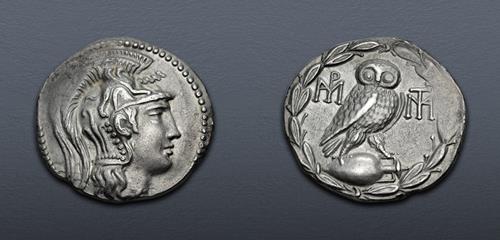|
ATTICA, Athens. Circa 165-42 BC. AR Tetradrachm (30.5mm, 16.10 g, 12h). New Style coinage. Roman occupation under Sulla. Struck 86-84 BC. Helmeted head of Athena Parthenos right / Owl standing right, head facing, on amphora; two monograms flanking, no letter on amphora; all within wreath. Thompson Group II, 1313 (same dies); HGC 4, 1777. Lightly toned, area of flat strike, minor marks. VF.
From the Kalevala Collection. Ex Classical Numismatic Group Electronic Auction 539 (31 May 2023), lot 120; William McDonald Collection (G. Bell, 27 September 2012), lot 125.
During the First Mithradatic War (89-85 BC), Mithradates VI of Pontos posed as the champion of Hellenic civilization against the rapacious Roman businessmen, grain merchants and tax farmers who had made themselves widely hated by local populations. In 88 BC he instigated the Asiatic Vespers, a pogrom that claimed the lives of at least 80,000 Roman civilians throughout Asia Minor. Mithradates believed that Rome, still struggling to contain the costly Social War in Italy, was in no immediate position to retaliate. He did not count on the determination of Lucius Cornelius Sulla, elected consul in 88 BC, who quickly raised five legions and marched east to crush the Pontic uprising. In the meantime, an anti-Roman tyrant named Aristion had seized power in Athens, blocking Sulla’s path to Asia Minor. Landing at Dyrrhachion in Illyria, Sulla’s force marched on Athens and placed it under siege in the autumn of 87 BC. It proved to be a long, bitter slog. After five months, the citizens of Athens were reduced to gnawing on shoe leather, and Sulla learned that the government in Rome had been seized by his hated rival, Gaius Marius. Rejecting demands to give up his legions, on 1 March, 86 BC, Sulla ordered an all-out attack, and the inner walls of Athens were finally breached. The greatest city of Greece was given over to rape, pillage, and fire until two of Sulla’s Greek friends persuaded him enough was enough. Aristion and his supporters were rounded up and executed. Athens, now largely in ruins and its population decimated, received a Roman garrison under Sulla’s quaestor, M. Licinius Lucullus, to ensure its continued submission while Sulla proceeded to confront Mithradates in Asia.
The Sullan campaign against Athens has long been associated with two distinctive but differing issues of silver tetradrachms on the familiar Athenian “New Style” pattern, one with with a pair of simple monograms flanking the central owl, and another with trophies in the same position; in each case these symbols replaced the elaborate mintmarks and magistrate names found on “regular” New Style owls. E.S.G. Robinson proposed that the monograms can be resolved as TAM(IOY) and MAP(KOY), the latter possibly referring Marcus, the younger brother of Lucullus. This theory was endorsed by Margaret Thompson in her corpus on the New Style coinage (pp. 434-5). Whether either or both of these issues came before, during or after the siege of Athens is unclear, but the stylistic differences with the regular New Style coinage indicate they were struck at a moving mint in the Roman camp, possibly from silver looted by Sulla from temples throughout Greece. In such case these “Pseudo owls” may plausibly be identified as the “Lucullan coins” mentioned by Plutarch in his biography of Lucullus that were prized by troops for their silver content and wide acceptance. Another contemporary inscription from Delphi refers to three slaves being freed for the sum of “105 Lucullan flats,” perhaps referring to the broad, flat fabric of these coins.
The final winners of all CNG Feature Auction 129 lots will be determined during the live online sale that will be held on 13-14 May 2025. This lot is in Session One, which will begin 13 May at 9 AM ET.
Winning bids are subject to a 22.5% buyer's fee for bids placed on this website and 25% for all others.
We recognize that our users may have various Internet Browsers and Operating Systems. We like our visitors to have the best possible experience when using our bidding platform. However, we do recognize that it is impossible to develop applications that work identically, efficiently and effectively on all web browsers. The CNG bidding platform supports the latest stable major version and stable previous version of Chrome and Firefox.
|
